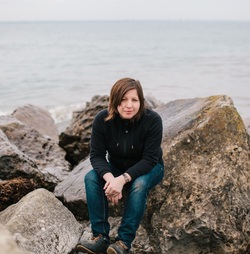|
When I think of positive associations with clothing, I think of favourites, wearability, great fit, humorous or funny colours and interesting textures. When I think of the negative associations, I think of rigid beauty and sizing standards, coffin clothing (a term that describes rather 2 dimensional clothing), esoteric fashion history references and trend analysis. I felt that in school trend analysis and sizing was a huge thing. There was very little interest in the process of developing a personal structure for idea development, working style or creative problem solving. So Part 2 is about that…..
When I graduated from fashion school I took a job doing piecework, cutting and eventually designing for a now large label in Toronto. On my breaks I would have a knit or crochet sit in with my fellow co-workers and I found it therapeutic. We would do math calculations to switch a knitted garment to a crochet one or to adjust the gauge for a different yarn thickness. Around that time I had bought an LK150 knitting machine to experiment. It was a sad little plastic machine that held no charm for me. I’m afraid I swore off machine knitting for another five years. But I continued to knit and crochet, even at one time doing crochet piece work in the form of openwork cotton sweaters as well as continuing to design easily sewn, trend appropriate clothes for the label I worked at. A lot changed when I went back to school for textile design at Sheridan College. I can’t say enough great things about that program except that perhaps it should be a degree program rather than just a diploma program. I learned how to develop original creative work from brainstorming, used sketchbooks to record qualities of line and material, began to use log books, as well as collage, and intuitive creative play. These are great tools that allow me to record results, build shapes and above all develop original work. At the time I was focused on screen printing which is very close to painting. I have logbooks from this period with detailed information on colour mixing, effects and results. I use this same method today with my knitwear. After graduation I struggled a bit to find my footing. Screenprinting and garment making in Canada is a very competitive space. I had developed some silkscreened knitwear which I really enjoyed as well I spent a lot of time deconstructing second hand garments from vintage and thrift shops. I was really drawn to the sweater aisles and from there collages, and sketchbook work from sweater scraps emerged. Around the same time I picked up an old dubied hand flat knitting machine in dire need of restoration. Its wooden handles and solid metal frame felt so inspiring, it reminded me slightly of my dad’s clockmaking machines which were built to last. This was a far cry from the LK150 I bought five years before. The Italian lady I bought the Dubied from lived close by in Stoney Creek. She was still wearing garments made on the Dubied and they were absolutely beautiful. She had old cones, old magazines and some wonderful descriptions about the types of garments she made over the years. She seemed upset about selling her knitting machine which struck me as odd. I distinctly remember her sitting me down to tea outside her 1950's bungalow in the summer with a Chuawawa sitting on her lap. At this point I spent a few years educating myself with books and manuals on how to operate hand flat knitting machines properly. There seems to be so much information on hobby machines but so little on hand-flats. It was very intriguing. I turned to logbooks to record my findings and I worked this helped me to replicate effects and feel some progress. At this time I was still silkscreening. My switch to knitting was ugly and dramatic when I lost my studio space due to a horrible landlord. I spent some time thinking about my direction. I loved that the knitting machine allowed you to design and control the fabric itself. One could knit complex textures injecting a warmth and personality into a garment…. So I bought some more knitting machines…..
0 Comments
Leave a Reply. |
Anna is a Hamilton based knitwear and textile practitioner blogging about her collection development as well as pre-1950's knitwear technology.
Links
Emma Gerard Make something bookhou Iben Hoej krystalspeck workshop bespoke truckee amy lawrence designs Categories
All
|


 RSS Feed
RSS Feed